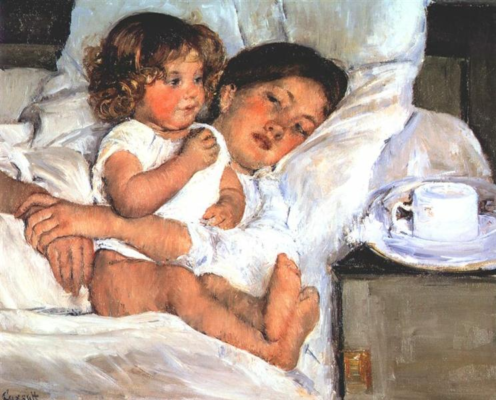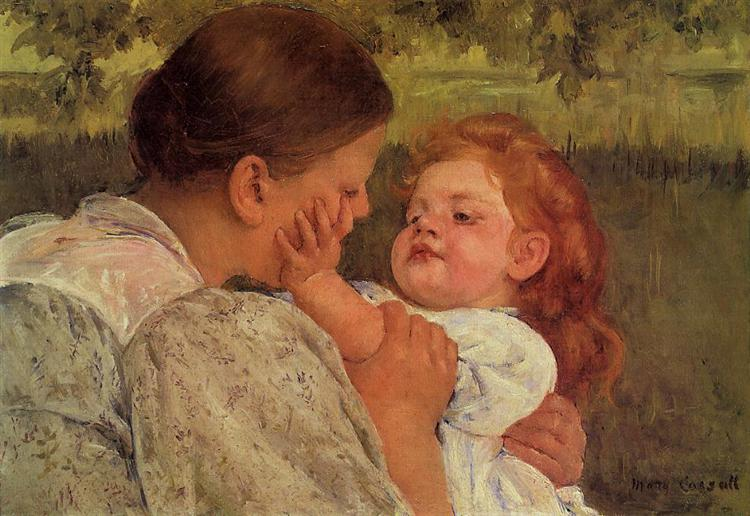There is arguably nothing more heartwarming than seeing the love shared between parents and their children. It is something so fundamental to life and is something that is shared and experienced by practically every creature on our planet.
For American Impressionist painter Mary Stevenson Cassatt, this theme of family and relationship was the core of her career as an artist. In fact, she would go on to paint over one hundred paintings on the subject.
Cassatt’s paintings are synonymous with the mother-child relationship, and she is regarded as this genre’s best and most famous painter. Let’s look at some of her best-known works and study the deeper themes behind them.
Table of Contents
Maternal Caress (1891)
While most Impressionist painters of the movement focused on scenic views and urban settings, American painter Mary Cassatt gave her attention to portrait pieces. In particular, Cassatt became famous for her loving depictions of the everyday domestic duties of women.
This was when women were fighting for equal rights, and the feminist movement was gaining ground in western society. Cassatt was an avid proponent of women’s rights and acted as an example for the ‘new woman’ of the 20th century, who was both independent and successful.
In the painting of the Maternal Caress or the Nude Child as it has also known, a woman is portrayed holding an infant child. The sharp brushstrokes and simple color scheme influenced the Japanese art style that became widely popular in the West at the time.
Children in a Garden (1878)

Children in a Garden is one of the first paintings Mary Cassatt would devote to the themes of parenting and motherhood. It would soon become her primary identity as an artist, and she dedicated dozens of paintings to the relationships between parents and their children.
In particular, she focused on the intimate bond between mother and child. But, it is fascinating to note that although Cassatt seemed to truly adore this affectionate relationship and the idea of the traditional family. She never actually married or had any children of her own and was a feminist at heart.
In her painting of the Children in the Garden, a young child sleep soundly in a pram while their older sibling plays nearby. They are both being watched over by what looks to be their nurse, who is busy knitting giving her an impression of disinterest.
As well as being a painting about the nurture of youth, it can also be seen as social commentary on the fall of the family values in modern times, where parents no longer directly see to raising their children. This would be a recurring theme in Mary Cassatt’s artworks.
The Child’s Bath (1893)
The Child’s Bath is one of Mary Cassatt’s famous paintings, and for a good reason. It beautifully and poignantly encapsulates all the symbolism and ideals Cassatt held dear to her heart, and the idea of tenderness shines through here.
Cassatt would paint many paintings of mothers bathing children. While these paintings represent unconditional love and devotion, they can also be seen as a reference to Jesus Christ’s washing of the feet parable and the message that story contains.
Like many of Cassatt’s paintings, it was influenced by the influx of Japanese artwork into western culture. In this case, the inspiration came from Japanese prints by fellow Impressionist artists and friend Edgar Degas. Like many Impressionist artists of the time, much of Cassatt’s artwork would be directly influenced by this Far-Eastern flavor.
The Boating Party (1893)
oating Party differs from Cassatt’s other paintings in that it depicts both mother and father alongside their infant child. In addition, it is one of the only paintings she ever created with a man as its centerpiece.
It subtly displays the fundamental theme of the traditional family, with the motif of the man steering the ship acting as an artistic representation of the head of the household. It also keeps the symbols of the mother embracing her child accompanied by water which is synonymous with Cassatt’s artworks.
It is Cassatt’s largest mural painting and was the magnum opus of her first solo exhibition in America. It stands proudly alongside other magnificent boating-themed Impressionist paintings by renowned artists such as Renoir, Manet, Seurat, and Monet.
Breakfast in Bed (1897)

Breakfast in Bed is perhaps Mary Cassatt’s most famous and well-known painting. It is one of those famous paintings that almost everyone has seen at one time or another but perhaps were unaware of who painted it.
As it is an Impressionist painting, the heartfelt feeling, and sheer emotion can be felt radiating outward from the image on the canvas. The mother gazes lovingly at her child while embracing her tightly.
Mary had been painting scenes like this for over twenty years and had perfected the theme by this time. The painting is both touching and emotionally moving while at the same time remaining realistic and pragmatic. It embodies everything Cassatt stood for as an Impressionist artist.
Conclusion
For American painter Mary Cassatt, art was an opportunity to express the fundamentals of love and family. Unfortunately, she may not have had a family of her own. Nevertheless, her artwork embodied these ideals as well as any other artist. Learn more about Mary Cassatt’s other famous paintings online or in your local art gallery.

